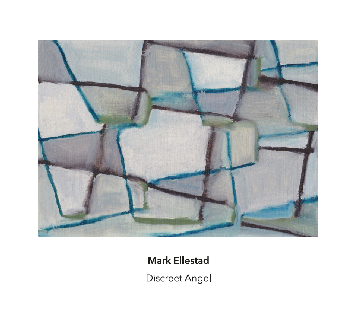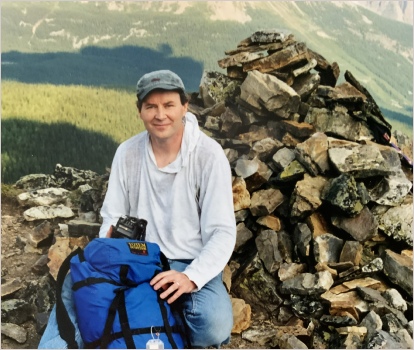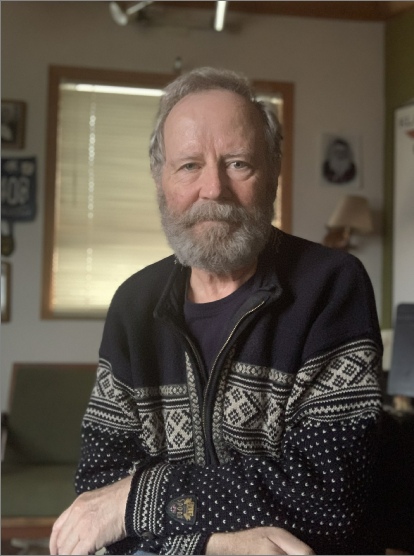Another Timbre TimHarrisonbre

at185 Mark Ellestad ‘Discreet Angel’
1. Discreet Angel (1990) 20:14
Cristian Alvear, guitar
2. Sigrid (1994) 6:20
Mark Ellestad, pump organ & Hardanger fiddle
3. In the Mirror of this Night (1988) 45:49
Apartment House: Mira Benjamin (violin) & Anton Lukoszevieze (cello)
Youtube extract (Discreet Angel)
Youtube extract (In the Mirror of this Night)
Interview with Mark Ellestad
I guess not many people will have heard of you, so can you tell us about your background in music?
When I was 8 years old, my school was offering music lessons to any student who was interested. I wanted to learn piano, like my older brother. But the piano classes were filled so I was placed with a violin teacher, which was a major disappointment. During the coming years, though, I got the opportunities to play in school orchestras and eventually in quite a good youth orchestra.
Along with the violin training there were basic lessons offered in music theory from a local music conservatory. For a number of reasons, the theory lessons were more destructive than useful, which had some long-term consequences in arriving at a basic fluency in western classical music theory.
I had a natural love for music. My years with the Calgary Youth Orchestra revealed the excitement and beauty in orchestral music and it was a great place to develop friendships.
I decided to pursue music as a career, but as a composer not a performer. I had met my future wife in youth orchestra. She was accepted into a medical program at the University of Alberta in Edmonton. I followed her there and did an undergraduate degree in music theory and composition. This is where the difficulties with standard western classical music theory began to generate some roadblocks.
My wife was offered an internship in Victoria, British Columbia, and so we went there in 1980 and I finished up my BMus at the University of Victoria. We returned to Calgary during 1981 but I had a longing to return to UVic to complete a Masters degree in music. It was a life-changing period for me. This is where I had the opportunity to study with Rudolf Komorous and it is where I met some wonderful young composers who became close friends.
Studying at UVic broke open entirely new ways of thinking about music theory and composition. Much of what I had understood music to be, at that point, was shown to be marginal. With the sharing and the friendships and the mutual curiosities and the support, it was like an explosion of wonder and possibility. I completed my MMus at UVic in 1984.
Yes, that generation of composers who passed through the music department of the University of Victoria around that time is really special. But carry on….
My wife and I had decided to make Victoria our home. Our two children were born during my time in the MMus program and we loved the city. Rudolf Komorous asked if I would write a woodwind quintet to be performed at the Victoria International Festival of Music in 1986. "No Moon, No Flowers" is the result of that commission. A chamber work for diverse instruments called “Dangling from the Wall” was written for the Dream Ensemble (in Victoria) and premiered at Open Space Gallery.
But my father became quite ill in 1985, and we moved back to Calgary in 1986 to help out in any way we could. There was a home for sale just a few blocks away from my parents, so we bought it and settled there. I built a little studio in the back yard and that was where I wrote all of my subsequent pieces.
So tell about the three pieces on the CD? When were they written?
The three works on the CD were written between 1988 and 1994. It is a long time ago and there were many factors that played in to these pieces becoming somewhat hidden for a couple of decades. In 1994 I had some CDs manufactured that represented some of my work at the time. Most of the discs were mailed out to various people and institutions internationally with the hope of generating some interest in the music. And I distributed many others to local musicians. Thanks to my good friends at the time, each piece had at least one or two live performances in Canada. I had studio recordings of a few pieces, but the violin and cello duo “In the Mirror of this Night” was something I only had a good live performance of. And it was the duo that I felt an urge to get a good studio recording of before it was too late. But that proved to be a more difficult journey than I had expected.
“In the Mirror of This Night” was written in 1988, shortly after my father had died. It was written for a concert devoted to my music at the Open Space Gallery in Victoria. The wind quintet was the other work on the program.
“Discreet Angel” was written in 1990, shortly after my mother had suddenly passed away. It was created as the audio part of an installation that I collaborated on with a professor of architecture at the University of Calgary.
There were several other works written between 1990 and 1994. In June of 1994, I started an on-location audio recording business with a friend. The CD of my works was created in the backyard studio which also became the editing/mastering studio in the business for many years to follow.
It was also in 1994 that a new world broke open for me in music. I was watching the opening ceremonies of the Olympic Winter Games that were hosted in Lillehammer, Norway, and heard, for the first time, the Hardanger fiddle. I became obsessed with trying to find one and eventually one became available for sale on a news group. I bought it and tried to learn it as best as I could in isolation from others who were performers. This opened up a whole new world of wonder for me. And it eventually allowed new paths to open up and brought many wonderful friends. The traditional music for Hardanger fiddle is some of the world’s most amazing music. It’s not everyone’s cup of tea, but it made a deep impression on me, which continues to this day. “Sigrid” was made during that time in 1994. It is its own thing, but a few works that followed had some experiments with folk music fragments.
By the end of the 1990s, many life issues began to create doubt and deference. I put composing into the background to protect it, in a way. And I focused my musical energies on the recording business, believing that it wouldn’t be long before I would be writing again. And just like that, years go by.
So how is it coming back to these pieces 25 or 30 years on, and hearing new realisations of some of them? To my ears they still sound remarkably contemporary, but for you do they belong very much to the past?
It’s a great gift to have been offered these new recordings of “In the Mirror of this Night” and “Discreet Angel”. The musicians have approached their interpretations with restraint, patience, stillness and a willingness to bring flexibility to time and repetition. I love what they have done; I love their sound worlds; I love the virtuosity that they each bring to restraint. And I feel settled that they have hit the essence of what the music is. I am grateful to each of them; and I am grateful that this music has found a home on Another Timbre.
As to the music sounding contemporary this many years later, I can say that that is something I have never really considered. I have heard the old recordings many times and have enjoyed the journeys that they have offered me. In some ways they have become a little like family and it hasn’t occurred to me to wonder where they belong within the scope of new music. Maybe it’s something like a good pair of shoes; they offer comfort and support and can open up opportunities to travel a little. They’re just good friends, that’s all.


Mark Ellestad, 2022
Mark Ellestad at the time of composing the works on the CD